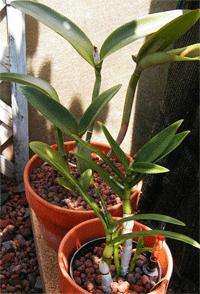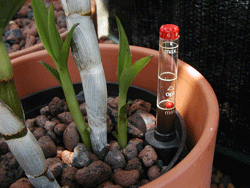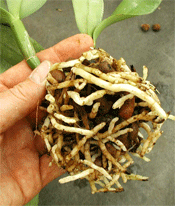

Plant Care for Outside Growing |
||
Summer months are the active growing season for most orchids, especially if they're outside. This means making some adjustments in your plant care. |
||
| Light:
Outdoor light is much stronger and more intense than indoors. (Midday sun outdoors can be 10 times stronger than sun that shines through a window.) For the first couple of weeks outside, protect all your plants by keeping them in total shade - even "high light" orchids. In a couple of weeks, after they acclimate to being outside, start moving the high light plants (Cattleya, Dendrobium, Cymbidiums) into more sun. A couple hours of early morning or late afternoon sun is ideal. Dappled sunlight throughout the day also works. Always avoid direct midday sun - even high light plants will burn. |
 Example of dappled sunlight, perfect for most orchids |
|
| Water: As your plants transition to outdoor growers, they'll drink copious amounts of water compared to indoors. Sometimes as much as 2-3 times more! That watering schedule of once every 2-3 weeks will probably change to once a week outside. The good news is watering won't be a problem if you've set up your plants properly (see setting up your plants for outdoors). Orchids spring to life outdoors in the summer. Water to the "opt" marking on the gauge (that's 1/2 way up). When the gauge reads "min" rewater - no dry period necessary. Always allow enough time for the gauge to go down before rewartering however. Most plants will use up their water in a week. On the other hand, if a rainy period has your orchids standing in water for a week or more, I recommend forcing a "dry period". Using one hand to steady the plant (and holding the pebbles in place) dump out all the water in the saucer. If you're using grower trays, remove plants from the tray and pour out all the water. Don't rewater for several days. Those roots need air! |
 Follow our guidelines for setting up your orchids for "outside growing" and you'll never have to worry about watering again - even with a garden hose! |
|
| Nutrients:
Your plants are actively growing and they're hungry! Apply full
strength
nutrients every watering. (We use and recomend Dyna-Gro 7-9-5,
1/2
tsp.
per gallon.) Occassional rain showers will flush the system. If your plants are protected from the rain, flush out the system every couple of weeks by pouring clear water (no nutrients) through the pebbles until it drains out the bottom of the pot. The garden hose works well for this. I add Pro-Tek (1/2 tsp. per gallon) to the nutrient solution during the summer months. Pro-Tek adds silicon to the mix which makes the plants more heat tolerant and drought resistant. |
 Healthy roots on a Cattleya (from last summer). |
|
Temperatures: Another advantage to growing outside are the temperatures. Unlike houseplants, orchids welcome hot days and chilly nights. Most orchids enjoy temperatures into the 90's during the day and as low as 50-55 degrees at night. Don't worry about hot weather. As long as your plants are protected from direct, mid-day sun they'll be fine. Mother nature designed orchids to handle the heat by using the air moving over their leaves to keep cool. If your plants are getting a breeze, high temperatures won't be a problem. A gentle shower from the garden hose always helps too. |
||
| Growing
Orchids
Outdoors for Summer Setting up Hydroponic System for Outdoor Growing Tips for Growing Several Common Orchids Outdoors |
| The Stuff You'll Need Out There.... | ||||
Replace Outer Pots  Plastic Saucers |
Replace Outer Pots  Grower Trays |
Perfect media for outside growing  Leca Pebbles |
||
Great
all-around nutrient DynaGro 7-9-5 |
Switch
to Bloom when you see flower spikes DynaBloom 3-12-6 |
Bloom
Booster Mag-Pro 2-15-12 |
Stop
Insects before the start Pro-Tek 0-0-7 |
|
| Home | About Us | FAQ's | Contact
Us |
View Cart |